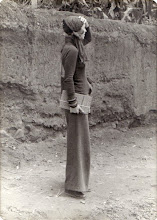
Marta Minujín, an Argentine artist who splits her time between New York and Buenos Aires, is somewhat of a national heroine in Buenos Aires, where her exotic life and history are common knowledge and her works are instantly snapped up by the top collectors, museums and galleries. Each feeding the other, her popular and artistic reputations are the product of both her self-cultivated exotism, atypical life and intentionally avant-garde art, as well as her international projection and the cultural rewards reaped by the Argentine national pride. After catching the eye of a porteño art critics in the sixties, she was sent on the typical trip to the 'developed world' with a Guggenheim scholarship (beca?), rubbign shoulders with the Informalists in Paris and the likes of Rauschenberg, Niki de Saint-Phalle, Jean Tinguely, Christo, etc. Backed by a ridiculously wealthy right-wing Argentine husband, she catapulted herself to media and art-world fame in Argentina with her elaborate happenings constructed in labyrinthine constructions of mixed media. Noticed in New York, she participated in the 1970 Information show at MOMA, whose catalogue goes for more than some Argentine art today. While her work was snapped up by Buenos Aires' top gallery (Ruth Benzacar), and by top collector and founder of MALBA, Eduardo Constantini, she was being shown in NY and DC (MOMA, Corcoran)and with extravagant public works in the Olympic Village in Seoul, Dublin and Argentina. The value of her work was further increased by a media-conscious collaborative happening with Andy Warhol where she "paid" back Argentina's foreign debt by handing him corn, Argentina's top produce. Associated with the feminist movement and participated in Wack! Art and the Feminist Revolution, at MOMA further added value to her work.
Now at Heather James Fine Art/Rohrer Fine Art, she is also a cultural product of Argentina - her work is used to sell painkillers (Tarifol) by the Buenos Aires ad agency Quadro. At the Límite Sud art fair this year in Buenos Aires, she encased a hundred Diesel perfume bottles in white-washed, emptied champagne bottles, corked with small sculptures of her sunglass-ed head. Called an olfactory piece, it invited the public to snip one of the hanging bottles and either keep it as a multiple or break it to complete the piece and discover the smells inside - a "participatory" sculpture, further valued by those who dared snip - the porteño art glitterati. 

Her Kate Moss moment, getting caught with cocaine upon entering Argentina, added to her beloved celebrity aura, as do her numerous public appearances and the "Todo es arte" mantra that keeps her close to the plebs while feigning disinterestedness, and creating the genius image.
Although the prices of her work were hidden on Artnet and such databases, here is an interesting conversation on the valuation of her and Argentine art with the head of Wanted Art magazine, the New York component of the Argentine D-mode, Carmen Ferrayra:
CF “Do you think argentine art is well-valued?”
MM “I think everything is cheaper, awfully cheap, in Argentina and abroad. Furthermore, we plastic artists aren’t appreciated, we don’t get retirements, for example. Think of those old artists, those that die without becoming recognized: all their work goes to the garbage. There should be a place to keep all this work as a testimony to history. I am successful, but how many people are? I know thousands of artists that accumulate paintings and paintings and nothing. If they’re not known, their work doesn’t have any value and they throw it in the trash. Humanity doesn’t realize that they’re throwing poetry in the trash.”
CF: “How do you decide what is good and what’s bad and how do you decide on the value of a work?”
MM: “There are very good works and I realize this. The value they must have is the value of the current market. If the current market is between $300.000 to $400.000, Argentine works should have the same value. When you go to any gallery, those are the prices, but in galleries that sell Argentine art, you see that the prices are around $20.000. Think of the work I did with Andy Warhol, he’s here, I took his photo live, it should be worth much more. But the problem is that there is no Argentine market that’s defended (propped up? Supported?).
CF: “Though I see you’re determining the value of the work because it’s Andy Warhol, and it should only be because you did it, and it’s a work with a profound content.”
MM: “Yes, that’s what it should be. It’s a conceptual piece, where I paid him the external debt. Since it was a conceptual piece, it is very very cheap.”
CF: “But if you compare, there are many artists that are getting the same prices as artists abroad. What do you think about that?”
MM: It has nothing to do with it. The artists fro abroad price their work at $300,000 and we price ours at 50.000. Only the work of dead argentines are worth that, like Pettoruti.”
CF: “I’m thinking of the short-trajectory artists, works that go from 3.000 to 5.000.”
MM: “But that’s nothing!”
CF: “Coming back to you and your work, do you consider yourself an Argentinean artist, or a universal artist?”
MM: “I don’t consider myself Argentine, I consider myself porteña. An avant-garde porteña. For Argentineans, I am almost like Carlos Gardel: everybody in the streets talks about me. For them, I represent something very popular (accessible).”

She is definitely one of the great artists in Argentina. People think she is really talented and as you said she had an exhibition in the MALBA museum. When I made my Buenos Aires travel I remember <i saw her work in the Museo de Bellas Artes and loved it. I liked the country and its people, especially the artists, it is really worth it!
RépondreSupprimerbrooke